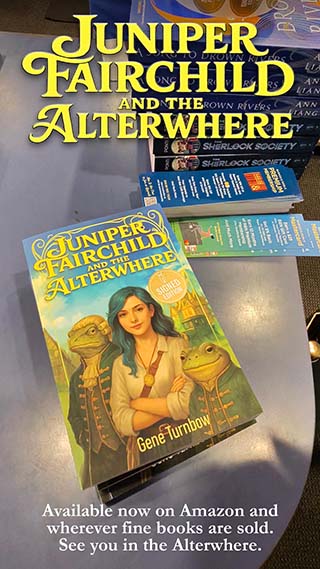In 1960s American television, the popularity of Westerns was waning, but spy programs were popular, and the fascination with science fiction was growing.
The Wild Wild West, which first aired September 17, 1965, combined all three.
Gene Roddenberry famously promoted the original 1966 NBC series Star Trek, featuring James Kirk, as a science fiction western. It was “Wagon Train to the stars.” But The Wild Wild West, which first aired a year earlier on CBS, was described by its creator Michael Garrison as “James Bond on horseback.” While the main characters, James West and Artemus Gordon, do travel by horseback, they usually travel by train. While the term “steampunk” didn’t originate until later, the show (1965-1969) is often regarded as the first teampunk program on television.

Premise
Unusual for a Western, the program’s opening title sequence is animated. The series then follows Secret Service agents James West (Robert Conrad) and Artemus Gordon (Ross Martin). The name “James West” may well be a combination of “James” Bond and the Old “West.” The partners investigate villains who threaten President Ulysses S. Grant, parts of the United States, the entire nation, or even the whole world. The villains they work to stop are often megalomaniacs.
The program began with James West working undercover as “a dandy, a high-roller from the East.” But the cover story was very soon dropped. West’s work in the Secret Service was preceded by his serving as an intelligence and cavalry officer in the American Civil War. (That war (1861-1865) ended 100 years before the TV program began. During the war, West served on then General Grant’s staff.) In the program, the character meets with the president of the United States in various episodes. James West is in many ways similar to the fictional British military officer turned government Secret Service spy James Bond.
Artemus Gordon, West’s Secret Service partner, was quite uncharacteristic for the early to mid 20th century Western genre. The creative inventor is a master of acting and disguise who uses more names that almost any television character. Whether the name Artemus Gordon was inspired by the 1930s Flash Gordon is debatable. But not only do they share the name “Gordon,” “Artemus” comes from “Artemis.” Artemis is a goddess known for shooting a flashy golden bow and arrow while Flash is known for shooting a flashy ray gun. The casting of Ross Martin also broke stereotypes of the time. The actor looked less like what a 1960s audience might expect for a creative inventor, and more like a gruff detective or villain.
The Wild Wild West’s most-seen villain also broke a stereotype. Capable villains in Westerns and spy programs were typically strong men of average or above average height. But the program’s best-known arch-villain was Dr. Miguelito Quixote Loveless. The highly intelligent but megalomaniacal enemy was portrayed by Michael Dunn who had medical dwarfism. Like the character, the 3 foot 11 inch Dunn was quite intelligent. The actor was reading at the age of 3.
The other recurring villain, who appeared twice, was Count Manzeppi portrayed by Victor Buono. And the “good guy” President Ulysses S. Grant was portrayed by James Gregory in the pilot, and by Roy Engel in other episodes.
The Wandering Train
Star Trek is known for the main characters’ starship Enterprise, and Lost in Space for the main characters’ spacecraft Jupiter 2. The Wild Wild West is know for the main characters’ train named The Wanderer. Only in the case of the train, the vehicle was real.
In the pilot episode “The Night of the Inferno,” the train was the same one already being used in the television comedy Petticoat Junction. But after that, The Wanderer was actually the Inyo. Appropriately enough for a steampunk program, the 1875 4-4-0 type locomotive, built by Baldwin Locomotive Works in Philadelphia, had been modified after the show’s era. In 1910, the Inyo train had changed from being a wood-burner to running on oil.
Technically, though, it was the outside of the train that was the real Inyo. The inside sections, with features ranging from a stable car to a laboratory, were constructed on CBS Studio Center’s Stage 6.
Gadgets and Inventions
In addition to the spying, what moves the show beyond being a standard Western is the technology. That’s what’s both used by the agents and by their enemies, with gadgets and inventions featured throughout the series. Some were due to the regular gadgeteer character Artemus Gordon, and some others were invented by the villains. Show writers often proposed an episode’s gadgets even before writing the episode. The devices include Jim West’s hidden sleeve gun and a breakaway derringer hidden in his boot heels. West and Gordon might face a giant flamethrower, bombs, or a flaming ghost mask. One could never know what an arch villain might invent. They were steampunk before there was a word for it.
Beyond the Acting
Some things were done by the actors themselves that would not ordinarily be expected.
Stuntmen weren’t needed as much as usual as Robert Conrad did many of his own stunts. But that finally backfired. In the third season episode, “The Night of the Fugitives,” Conrad was to do his own swinging-on-a-chandelier stunt. But instead, the actor fell 15 feet onto the stage floor and fractured his skull. As a result, the third season ended about a month and a half early. (The actor later recovered.)
Ross Martin’s extra contributions were quite significant but less dangerous. Playing the master-of-disguise Artemus Gordon, the actor portrayed dozens and dozens of “fake characters” using a dozen or more different dialects. The actor even sketched ideas for characterizations and worked in cooperation with the makeup artists.
But Martin had his own accidents and medical problems. The actor broke his leg in the fourth-season episode, “The Night of the Avaricious Actuary.” Martin had dropped a rifle, then accidentally stepped and slipped on it. Then, shortly after filming “The Night of Fire and Brimstone,” Martin suffered a heart attack. Ironically, this was on August 17, 1968, two years to the day after the show’s creator Michael Garrison died. In another irony related to Conrad’s and Martin’s falls, Garrison died from a fall.
Ironically, though, it wasn’t real-life injuries and violence that ended the program. It was fictional injuries and violence. Near the end of its fourth season, due to Congressional concerns over television violence, the highly rated TV series was cancelled.
Sequels and Spin-offs
The original The Wild Wild West began on September 17, 1965, and ended on April 11, 1969. But the steampunk series, sometimes called “network television’s weirdest western,” inspired more.
Conrad and Martin themselves appeared in two satirical comedy sequels. These were the television films The Wild Wild West Revisited (1979) and More Wild Wild West (1980).
Before that, Gold Key Comics produced a short comic book series based on the program. The comic book version started at about the end of the TV series’ first season.
The episode and production guide The Wild Wild West: The Series, by Susan E. Kesler, was released in 1988. And by 1998, Robert Vaughan had published the three novels The Wild Wild West, The Night of the Death Train, and The Night of the Assassin.
Then, seven years after the plan was announced in 1992, the film Wild Wild West (without “The”) was released in 1999. Conrad and Martin had played their roles straight in their appearances in both the original series and the semi-comic television movie sequels. But the 1999 film was played for laughs, which did not make Conrad happy. Will Smith, who played Conrad’s role as Captain James T. “JIm” West, later apologized.
The mark this series left on the sciffi zeitgeist is indelible. Whether done seriously, semi-seriously, or comically, the Western steampunk genre partially inspired by the series may forever remain the Wild, Wild West!
![]()
Alden Loveshade first thought of emself as a writer when in 3rd grade. E first wrote professionally when e was 16 years old, and later did professional photography and art/graphic design. Alden has professionally published news/sports/humorous/and feature articles, poems, columns, reviews, stories, scripts, books, and school lunch menus.
http://alden.loveshade.org













I absolutely love The Wild Wild West and have watched the entire series more than once. In the early 2000s, an editor I worked with asked me to write a weird western story. I jumped at the opportunity because it gave me the chance to write something in a world like The Wild Wild West. Eventually, I wrote a few more stories in that world and the whole thing came together into my steampunk novel Owl Dance.
Just a couple of additional thoughts. Another great Wild Wild West tie-in was a series of comics published circa 1990 by Millennium Comics. It did a great job of capturing the tone of the original series.
Also, you mention James Bond villains. It turns out Dr. Loveless’s assistant Voltaire from his first few appearances was played by Richard Kiel, who would go on to play the James Bond villain Jaws!
I knew you were a fan and writer of “weird westerns.” But I didn’t know/remember you were, like me, a fan of *The Wild Wild West*. I have a connection to owl dance in addition to having the book. As a child, I learned traditional culture and dance on an Indian reservation and performed locally with other children. And yes, members of that tribe still call themselves a “tribe” and still call themselves “Indians.”
I missed the Millennium Comics version. I just found references, but not in my original sources. So thanks for mentioning that.
I like watching my grandparent’s westerns but this was different. It starts with a cartoon of Jim punching a woman and then an upskirt shot.
And in one story they join the navy and fight a sea monster!
Starting a live-action dramatic program with a cartoon was certainly different, especially with a man punching a woman. Weirdly, though, “upskirt shots” were I think actually more common in cartoons decades earlier, before the Hays Code. (Betty Boop was known for that sort of thing.)
Thanks for mentioning the sea episode, which was “The Night of the Kraken.” I’d forgotten the actor Ted Knight, probably best known as Ted Baxter in *The Mary Tyler Moore Show,* was prominent in that story.